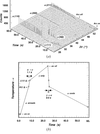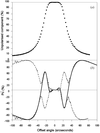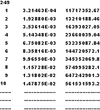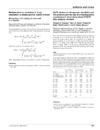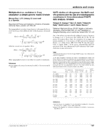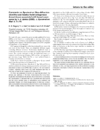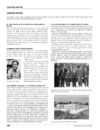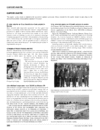issue contents
March 2003 issue

Cover illustration: Scanning electron micrographs of diamond refractive lenses etched 40 µm deep into a bulk CVD diamond substrate, see Nöhammer, Hoszowska, Freund & David, pages 168-171.
facility information
research papers
Magnetic X-ray absorption fine-structure spectra have been measured and analyzed for Ni–Mn alloys.
Time-dependent perturbation theory and a model form of the core-hole–photoelectron potential are used to obtain results for the secondary electron shake-off probabilities as a function of photon energy above the X-ray absorption edge. The shake-off probabilities and the resulting EXAFS amplitude reduction factor agree reasonably well with experiment close to an absorption edge and in the region of energy appropriate to EXAFS data analysis. The model form for the potential gives excitation probabilities which are too large at high photon energies.
Two scanning transmission X-ray microscopes featuring laser interferometry have been commissioned at the ALS. Improved stability and imaging properties, as well as efficient use of the instruments, has been achieved.
The technique of white-beam scanning X-ray microdiffraction when applied to samples consisting of multiple micrograins is described in detail. The application of the technique to two samples of thin-film metals is presented.
An approach to X-ray attenuation correction for diffraction anomalous fine-structure (DAFS) measurements is presented, taking into account energy-dependent secondary extinction effects.
High-resolution synchrotron radiation diffraction allowed solid-state kinetics and strain relaxation, as a function of time and temperature, in the nickel-base superalloy SC16. Precipitates are born coherent but lose coherencey afer a few hours, and decay times are comparable with the timescale of the increase of the γ′ volume fraction.
A novel time-resolved diffraction technique has been used to investigate phase-transformation dynamics and microstructural evolution in both the heat-affected zone and fusion zone in carbon–manganese steel arc welds during the welding process down to a time resolution of 50 ms.
Planar refractive hard X-ray lenses etched into bulk diamond have been developed. The lenses should be able to withstand the extreme flux densities expected at the planned fourth-generation X-ray sources.
The predicted performance of two phase plates on the XMaS beamline are confirmed by polarization analysis, dichroism measurements and reflectivity studies on UAs/Co multilayers.
CO oxidation with a Pt/ceria–zirconia catalyst has been studied by in situ X-ray diffraction at the beamline GILDA of ESRF. The time-resolved X-ray diffraction pattern of the catalyst was recorded by the translating imaging plate implemented at GILDA, while the CO2 yield was monitored by a mass quadrupole spectrometer.
An automatic procedure is described for calibrating the wavelength and the detector arm offset angle of angular-dispersive powder diffractometers at synchrotron sources.
A windowless small ionization chamber detector was developed at the European Synchrotron Radiation Facility for monitoring the intensity of the focused beam during X-ray microprobe measurements. In the present work the technical characteristics, such as the current–voltage curve, stability and linearity, of the small monitor were tested.
short communications
Some points concerning the characteristics of the X-ray simulation code SHADOW are clarified which are not correctly mentioned by Yamada et al. [J. Synchrotron Rad. (2001), 8, 1047–1050].
computer programs
An interactive analytical and data-monitoring program for small-angle X-ray solution scattering measurements that processes the data without disciplined knowledge of small-angle scattering is described.
addenda and errata
Free 

Free 

letters to the editor
Free 

The interpretation of data in the paper by James (2002) is questioned.
Free 

Concerns regarding aspects of the paper by James (2002) are given.
Free 

Responses are made to P. Suortti et al.'s and K. D. Rogers et al.'s comments in the two previous papers.
current events
Free 

Free 

Free 

Free 



 journal menu
journal menu





















